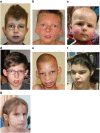Ten new cases further delineate the syndromic intellectual disability phenotype caused by mutations in DYRK1A
- PMID: 25920557
- PMCID: PMC4613470
- DOI: 10.1038/ejhg.2015.29
Ten new cases further delineate the syndromic intellectual disability phenotype caused by mutations in DYRK1A
Abstract
The dual-specificity tyrosine-phosphorylation-regulated kinase 1A (DYRK1A) gene, located on chromosome 21q22.13 within the Down syndrome critical region, has been implicated in syndromic intellectual disability associated with Down syndrome and autism. DYRK1A has a critical role in brain growth and development primarily by regulating cell proliferation, neurogenesis, neuronal plasticity and survival. Several patients have been reported with chromosome 21 aberrations such as partial monosomy, involving multiple genes including DYRK1A. In addition, seven other individuals have been described with chromosomal rearrangements, intragenic deletions or truncating mutations that disrupt specifically DYRK1A. Most of these patients have microcephaly and all have significant intellectual disability. In the present study, we report 10 unrelated individuals with DYRK1A-associated intellectual disability (ID) who display a recurrent pattern of clinical manifestations including primary or acquired microcephaly, ID ranging from mild to severe, speech delay or absence, seizures, autism, motor delay, deep-set eyes, poor feeding and poor weight gain. We identified unique truncating and non-synonymous mutations (three nonsense, four frameshift and two missense) in DYRK1A in nine patients and a large chromosomal deletion that encompassed DYRK1A in one patient. On the basis of increasing identification of mutations in DYRK1A, we suggest that this gene be considered potentially causative in patients presenting with ID, primary or acquired microcephaly, feeding problems and absent or delayed speech with or without seizures.
Figures


References
Publication types
MeSH terms
Substances
Supplementary concepts
LinkOut - more resources
Full Text Sources
Other Literature Sources
Medical

